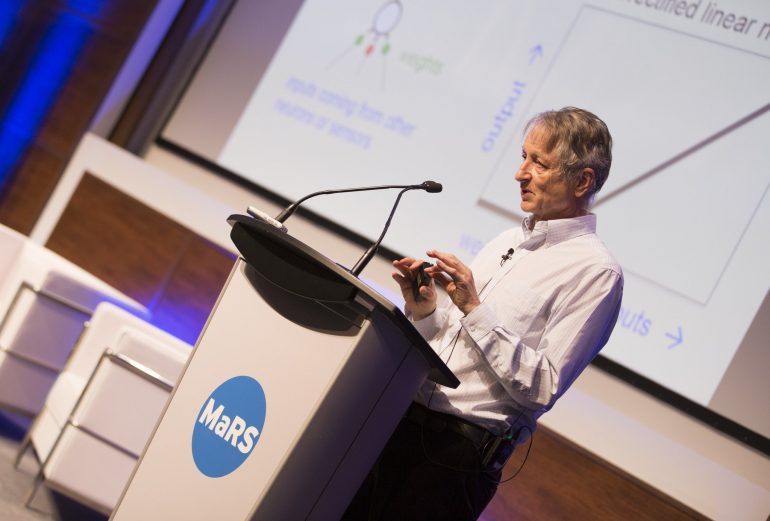Over the past three days, Elevate Toronto has explored the present and future of industries like FinTech, health, and work. Of course, a tech conference like this wouldn’t be complete without including AI, a growing industry in Canada as machine learning pioneers return to foster the next generation, and global giants rush to tap into the country’s talent.
To make sense of the jam-packed event, we rounded up five takeaways from the day.
Canada’s AI roots
Tomi Poutanen, co-CEO and co-founder of Layer 6 and a co-founder of Toronto’s Vector Institute, told the story of how the city has set itself up for the AI hype we’re seeing today. He said that Canadian AI pioneers Geoffrey Hinton, Yoshua Bengio, and Richard Sutton were once considered “outcasts” for their desire to study AI.
“In the 90s, the only real people pursuing neural networks were here in Canada, in Toronto and Montreal,” said Poutanen, who was a grad student in the 90s. He also ended up pursuing cryptocurrency over neural networks because he was told it was a “dead end.”
Here is a breakdown of our morning at #ElevateAI with some fantastic insights #ElevateToronto pic.twitter.com/tigLennlBN
— Nafis Ahmed (@snafisahmed) September 13, 2017
These pioneers would go on to giants like Google that would support their research, but now, they’re coming back to support the growing AI sector at home.
“We had the foresight to invest in something before it was trendy, and that has been the beginning of a critical mass that is having a big impact in our economic sector,” Bengio said.
The future of work
In his presentation, Geoffrey Hinton alluded to the potential applications of AI, including building machines that can diagnose better than doctors, and medical imaging applications that can interpret data better than radiologists.
Many people, understandably, have anxieties about how AI will impact the workforce as it displaces workers threatened by automation.
Gary Bolles, chair of the future of work at Singularity University, said that AI should be used as a tool for augmentation versus just automation. “It’s understandable [to be] automating tasks that humans perform,” said Bolles. “But the challenge of that model, which is often driven by venture-backed investment, is that it tends to need to find problems that are really big problems. But how do we think about skill augmentation and how do we find new activities?”
The talent issue
Bengio said that the demand for AI students is “tenfold” what we’re producing.
“First and foremost we need to keep profs in academia, and second, we need to recruit many more,” Bengio said.
Building an AI ecosystem. Six remarkable people. #elevateAI #elevateTo #ElevateToronto @IntegrateAI @steveirvine pic.twitter.com/0l6wk7hQB0
— Andrew Lo (@fastdrvr) September 13, 2017
Kathryn Hume, VP of product and strategy at Integrate AI, suggested that being transparent about your company’s mission is a strong recruiting tactic, even for global talent. “We hired a VP of engineering, and he had offers at nine other companies and he said, ‘I want to work you guys because you’re thinking about this ethically and you want to do it right,’ said Hume.
The co-creation model
An industry as complex AI requires several players to come together, and many panelists talked about the importance of collaboration with industry, academia, and government — and how to do it properly.
Jas Jaaj, partner at Deloitte, gave an example of how the company spun out one of their blockchain venture into a new and separate company after the success of the project. Today, Nuco is working to tackle the interoperability issue of blockchain.
As the development of AI requires high-quality datasets, Bengio said that this is an area where the Canadian government can play a role because of our centralized healthcare system.
“I see the opportunity with startups and small companies. But they don’t have datasets. It would be nice to marry large Canadian companies with those coming from late companies and startups,” Bengio said.
Where we’re at with AI
While AI is going through a hype cycle in Canada right now, Poutanen stressed that we still have a long way to go before robots think independently.
AI is an existential crisis so we need to win #ElevateToronto pic.twitter.com/jWxsjS470x
— Alison Gibbins (@alivey) September 13, 2017
Bengio doubled down on this issue. “The fact that we use AI as a term is also not the best,” he said. To him, ethical issues with artificial intelligence — such as their use in the military — are more pressing.
“It’s not grounded with the real AI we are doing in labs. We need to better communicate the short term issues instead of long-term things.”
Photo via MaRS


